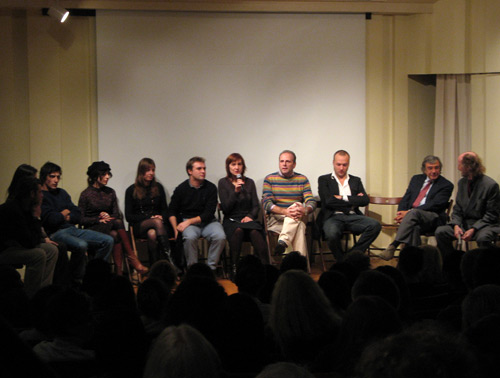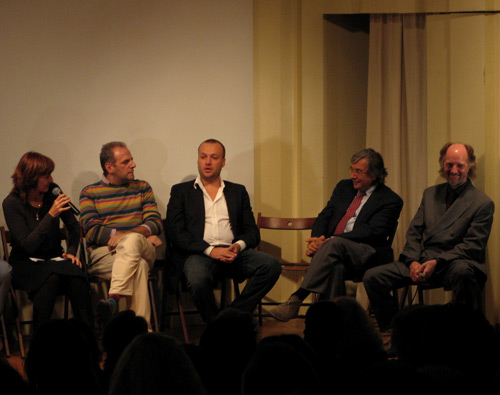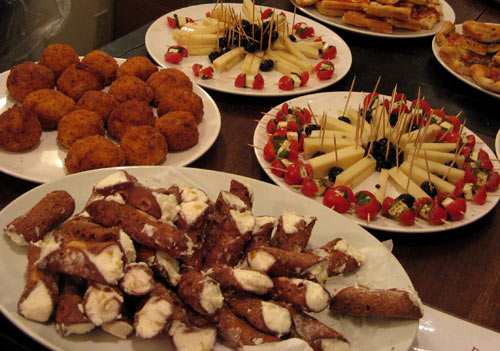N.I.C.E. Festival
The mid-19th-century mansion on West 12th Street, known as the Casa Italiana Zerilli-Marimò is home to the Department of Italian Studies at New York University. The space sponsors Italian-based cultural events like concerts, art exhibitions, films and lectures, such as tonight’s program for the N.I.C.E. ( New Italian Cinema Events) Film Festival, sponsored by the Italian Cultural Institute and the Tribeca Film Festival.
The panel discussion was on “The Future of Italian Cinema,” and featured directors, producers and actors from the films included in the series. The group was moderated by Deborah Young, a film critic for Variety (at center, with microphone.)

Quite a impressive number of guests had turned out for the event, which indicated a far healthier interest in Italian cinema than I would have expected. Things have certainly changed from the post-World War II heyday of foreign cinema, and Italian cinema in particular. Up until the mid-1940s, foreign films were a cottage industry, evolving out of two distinct camps: arthouse films (usually French and Soviet) marketed to a coterie of highly educated cinerati; and films in German, Greek and Italian, usually shown without subtitles to audiences of recent immigrants homesick for their home country fare. There was a shift after the war: GI’s returning home from their first time abroad maintained residual interest in the cultures of Europe and Asia–and particularly in the women they had encountered. American producers catered to this burgeoning interest in the exotic (or erotic) by importing actresses from Europe, and especially Italy: Gina Lollobrigida and Sophia Loren among them. Among leading men, Marcello Mastroianni achieved international fame as the screen symbol of the modern European.
Directors Federico Fellini, Bernardo Bertolucci and Pier Paolo Pasolini were near household names. Some of their films became mainstream hits, like Fellini’s La Dolce Vita; the image of Anita Ekberg wading into the Trevi fountain, remains iconic to this day. Suddenly Italian cinema was all the rage. In the years after La Dolce Vita, dozens of Italian films played the big cities to crowds of foreign-film fans who sought them out for a glimpse of their exotic beauty.
Trends do run their course, though, and by the mid-1960s the foreign-language film wave started to ebb. The arthouses that had regularly promoted foreign cinema switched to homegrown independent movies. Foreign-film revenue gradually dropped from its 1960s high of about 5% of the total United States box office. Today it is .5%—one-tenth what it once was.
With a few breakout exceptions (Life is Beautiful, Crouching Tiger, Hidden Dragon), foreign films have become marginalized as they were before World War II–patronized by a small group of Americans, and by a significant slice of first- and second-generation foreigners: the Indian diaspora that still seeks out its Bollywood musicals.
In the meantime, Italian films have suffered from lack of interest outside Italy, which in turn, impacts financing and, by most accounts, overall quality. The driving pop cultural force in Italy is television, which is infamous for its broad humor and scantily-clad girls. The panelists commented that despite the continuing popularity of such shows, there is a backlash forming from viewers craving more substantial fare. Italian independent film strives to address that deficiency.
One of the barriers to widespread international (read: American) appeal, it was suggested, is the necessity of subtitles. The classic retort about foreign film is that Americans don’t go to the movies to read. The question was posed: Might Italian filmmakers be better served by catering to an English-speaking audience?

The most enthusiastic applause of the evening was reserved for young film director Francesco Amato who declared, “I am an Italian film director. I make Italian films. I will never make an Italian film in English!”
Afterwards, there was reception in the first floor of the mansion with wine and food provided, courtesy of East Village wine bar Cacio e Vino. The restaurant is named for the traditional Roman pasta dish, cacio e pepe, which is basically pasta sprinkled with pecorino romano, salt and freshly grated pepper.
No cacio e pepe tonight–but I did enjoy the riceballs.

There are 2 Comments ... N.I.C.E. Festival
Look at all those yummy cannoli!
November 25, 2006
I had a delightful cannoli at the Sixth Avenue Street Fair from Fortunato Brothers in Williamsburg.
Go for it ...
Search
Popular Tags
Categories
Archive
- July 2010
- July 2009
- January 2009
- November 2008
- September 2008
- August 2008
- July 2008
- June 2008
- May 2008
- April 2008
- March 2008
- February 2008
- January 2008
- December 2007
- November 2007
- October 2007
- September 2007
- August 2007
- July 2007
- June 2007
- May 2007
- April 2007
- March 2007
- February 2007
- January 2007
- December 2006
- November 2006
- October 2006
- September 2006
- August 2006
- July 2006
- June 2006
November 22, 2006